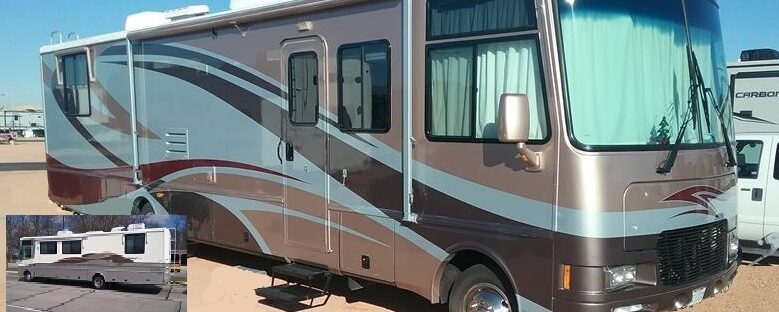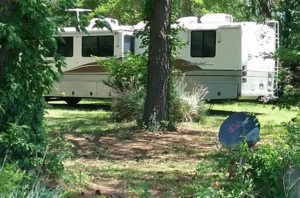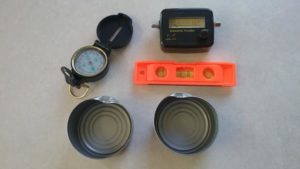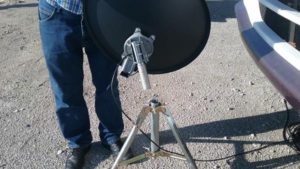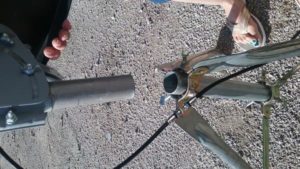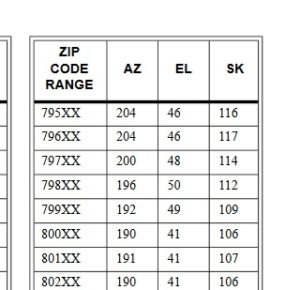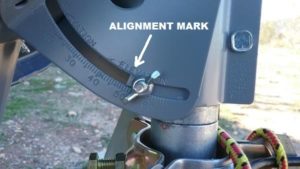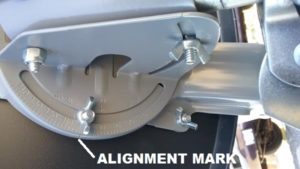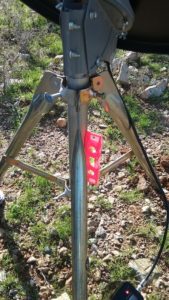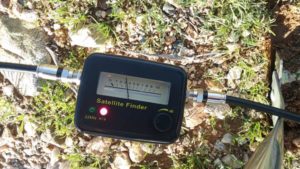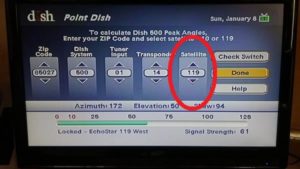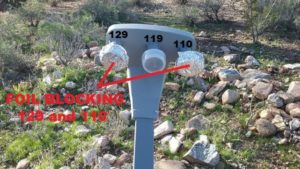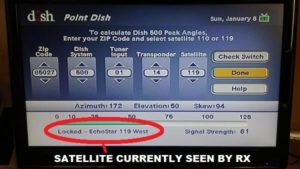Traveling with our home Dishnet VIP222 receiver.
Many RV’ers travel the country roughing it with a satellite TV receiver. Although most of these travelers have a dedicated receiver / antenna system while traveling, we simply pack up our home receiver and hit the road. Why not, no ones at home watching the home satellite, so why not use the home receiver while on the road. Its already paid for, so no extra fees for a different receiver or any pay-as-you-go plan fees.
USING OUR HOME RECEIVER
 We use our Dish model VIP222 home receiver while on the road. It’s a fairly new HD dual receiver, two receiver’s in one. This article can apply regardless of what receiver you have.
We use our Dish model VIP222 home receiver while on the road. It’s a fairly new HD dual receiver, two receiver’s in one. This article can apply regardless of what receiver you have.
We hit the US highways a few months out of the year with stops at different locations for a few days, a few weeks, even a month at one location.
Our VIP222 receiver uses the signals from three satellites that are received by the antennas Low Noise Feeds (LNB), 110, 119, and 129. The 222 receiver uses an external LNB switch to switch between the LNB’s. One coax cable runs from this switch out to the antenna where the antenna has an internal LNB switch to select which LNB the receiver wants to use.
Before disconnecting the home receiver, I marked all the cables, then took a photo of the cables. This makes reconnecting at home easier.
THE ANTENNA DISH 1000.2
I use the WESTERN ARC (sats 110, 119, 129) at home and while on the road. If you are in the upper north east part of the US, these may not work for you. The farthest north east we’ve used it has been in Washington DC and Virginia Beach, VA. no problems from these two locations, but I suspect we were at the very eastern edge of coverage for the western arc.
While traveling, I use a Dishnet 1000.2 antenna, this is identical to the antenna we use at home. This is a 3 LNB antenna purchased on e-bay that included a tripod, squawk meter, cable, and some other accessories.
Using a tripod has advantages, We can position it anywhere that has a clear view of the southern sky, and it only takes a few minutes to set up, point it, and start watching TV. I use these tools to set up and point the antenna.
Compass – This is used to find the general direction to point the antenna. This is the Azimuth (AZ) angle.
Squawk Meter – This is an inexpensive meter that shows signal strength and has an audio tone when its pointed at a satellite. It temporary connects between the LNBs and the receiver when pointing the dish antenna..
Bubble level – this one has a magnet on it to hold it to the mast while leveling. This is probably the most important tool. the mast MUST be level.
2 Cat food cans – these are used to cover the two outside LNBs when aiming. You could use any metallic object that blocks the signal, i.e. tin foil, to block the LNBs while aiming.
ALSO – I made some minor modifications to the antenna and tripod to make assembly, adjusting, and leveling a lot easier and more convenient. I replaced all the nuts with wing nuts to make assembly and adjustments easier. I also modified the mast tubes that mount the antenna to the tripod, a larger diameter tube stays with the tripod, and a smaller diameter tube stays with the dish. When setting up, the smaller diameter tube (antenna) slides down inside the larger tube (tripod). and are then locked into place with a thumb screw.
The 3 LNB antenna receives signals from three satellites, 110, 119, and 129. The VIP222 receiver uses all three satellites, depending what channels you’re watching.. The LNB assembly on the antenna has a built in switch that is controlled by the receiver. This allows the use of one coax cable to the receiver rather than two or three.
THE DISH
This is a manual antenna, it doesn’t auto point, but offers a larger antenna for better signals.
The antenna has a larger reflector and provides you with a stronger signal. Its less susceptible to rain fade and weak signals if you’re pointing through shrub, trees, or are on the edge of a spot beam.
I have a regular roof mount tripod that I modified to make it easier to setup. I replaced the nuts and bolts on the antenna with stainless bolts and wingnuts to makes it easier and faster to assemble and aim.
Depending on your receiver model, having the more expensive aiming meter isn’t necessary, but is a lot more convenient. The expensive meter can select the satellite (LNB) right on the meter and read the signal strength. On my setup, I select the LNB on the receiver’s “AIM DISH” setup page, and use a squawk meter to read signal strength at the antenna. The big difference is I don’t know what satellite the squawk meter is seeing, I need to go inside and look at the receivers “AIM DISH” page to see what sat the receiver is seeing.
The first couple times I setup, it took an hour. This was practice and learning. When I do it now, it takes probably less than 15 minutes. These are the basic steps:
- Find the antennas AZ, EL, and SK settings from either the receiver or the antenna manual. These are based on ZIP code.
- Find a nice location that has a good view of the sky where I need to point at. There are smartphone apps that make this easier, but after a couple setups, I use a compass for the azimuth (AZ) and I have a good eye to judge the elevation (EL) that the antenna needs to point at.
- Make the skew (SK) and elevation (EL) adjustments on the antenna feed assembly.
- Set up the tripod and level it. This is probably the most important step in this process, the mast MUST be level. Tie / weigh the tripod down so it can’t move.
- Place the antenna on the tripod and point it in the general direction (Azimuth)
- Connect the squawk meter between the antenna and the receiver.
- Cover the two outer LNBs so they cannot see any signals.
- Turn the receiver on, and select satellite 119 on the AIM DISH page. This selects the center LNB on the antenna.
- swing / tweak antenna to get the max squawking on the meter.
- Verify on the receiver I’m seeing the correct satellite (119) and signal strength.
- Tighten the antenna hardware so antenna can’t move.
- remove the LNB covers from the outer LNBs.
- Remove the squawk meter and reconnect coax with feed through barrel connector.
- Recycle power on the receiver, Watch TV
DETAILS
The location selected must have a clear view of the satellites, generally toward the south. There are several smart phone apps that can make this easier, but I’ve had good luck just eyeballing it, i.e. I stand at my proposed antenna location, and use a compass to look in the direction shown as AZ. I then look up, estimating the EL angle. The antenna can penetrate through minor foulage, but not to much. get the clearest view you can find. I’v had the antenna as far as 100ft with no problems. just use good quality RG6 coax as the cable.
When aiming the antenna, there are some expensive meters that make the job a little easier, but I’ve found the following procedure works and takes less time than using the expensive meter. Follow these steps.
1) Getting the pointing angles. There are several sources. Use the receivers Antenna Aim page or from the printed manual. You need a ZIP code of your current location. Use a mailing address and zip code for a location nearby. I use the campground Zip code, or a nearby town or business zip code.. We’ll need the complete address if we need to change our “Service” location (See NOTE 2) but we need the “zip code” to look up the antenna pointing parameters in the installation table.
Using the table in the “1000.2 Installation Manual” look up the Zip code and find the Azimuth (AZ), Elevation (EL), and Skew (SK) angles for pointing.
2) Assemble and adjust the antenna for the EL (elevation) and SK (skew) angles that you looked up. Snug the nuts up, but not to tight yet.
3) Level the antenna mast. I use a small bubble level and dig little holes or shim the legs, or whatever it takes to get the mast perfectly level.
THIS IS THE MOST IMPORTANT STEP – If the mast is not level, you could spend hours trying to find the correct satellites. However, if the mast is level, this process will take only a few minutes.
Position the antenna on the tripod and using a compass, point it generally in the AZ (azimuth) direction. Re-verify the tripod is level.
4) I installed a short piece of coax that stays attached to the antennas LNBs. I then run a long coax that connects to the RV and the Satellite receiver. Temporarily use the little Squawk Meter to connect the antenna coax to the receiver coax. Note on the back of the meter what connector connects to the LNBs and what connector connects to the receiver. Turn the Satellite receiver on, the Satellite receiver supplies power to the antennas LNBs and the integral LNB switch.
5) On the receivers “Antenna Pointing” menu. Select “119” in the Satellite window. This will select the center LNB (the 119 LNB) on the antenna, and is the satellite we will be looking for.
6) Install the cat food covers over the two outside LNBs, this will prevent them from receiving signals. we only want signals on the center LNB while aiming..
Turn the volume / sensitivity knob up/down until the meter just starts to move and you can hear a squeal from the meter. The meter will indicate signal strength of what its seeing coming from the center LNB.
Keep in mind the cheap squawk meter can only detect signal strength, it cannot control what LNB is used, identify the satellite, or tell what LNB is producing the signal. By blocking the two outer LNBs, we are guaranteeing the signal on the meter is coming from the center LNB only. We use the Dishnet receivers “POINT DISH” menu to tell us what satellite is currently being received.
The 1000.2 antenna is designed so that when aligned correctly, the center LNB will be pointing at and receive Sat #119, the left LNB #129, and the right LNB #110. By covering the two LNBs, we are making sure that we are not receiving #119 on either of those two LNBs while pointing the dish.
7) With the antenna EL, S correct and pointed in the general direction of the AZ, slowly move the antenna back and forth no more than 10-15 degrees. You should find a spot where the tone and meter reading on the Squawk meter raise and peak. This should be Satellite 119. If you don’t see a signal, double check that the mast is level, and the EL and SK setting are adjusted properly.
8) When you peak the meter, snug up the screw to hold the antenna at it current AZ. Go inside and look at the POINT DISH page, the bottom of the menu will show signal strength, and what satellite it sees. It should show 119. We want to make sure we are looking at 119.
If you’re in the western part of the US and the dish has a low Skew angle, its possible you could be pointing at satellite 110 or 129, as they are almost right next to each other. If so, you’ll need to turn the antenna about 10 degrees left if showing 129, or 10 degrees right, if showing 110 (viewed from back of antenna). You should be able to hear the meter tone drop, then come back up again as it sees the satellite. Re-verify to make sure the receiver is locking onto 119. (SEE NOTE 5) In the eastern states, 110 and 129 tend to be more above and below 119, The SKEW setting, the dish is almost sideways.
9) Once aligned with 119, I tweak the antenna elevation by pushing/pulling at the top of the dish to see if I get a increase in signal strength. also move slightly side to side to see if there is improvement. re-verify on the receiver that we are looking at 119.
10) Once I have good signal strength and the receiver locks onto it, I remove the two covers from the 110 and 129 LNBs, I also remove the squawk meter and replace it with a simple straight through barrel connector.
11) Turn the receiver OFF, then on again. The receiver should start trying to acquire channels and the channel guide. This can take a few minutes (SEE NOTE 1)
NOTES
Note 1 – HARD RESET OF RECEIVER
If the receiver has a warning message that says the card isn’t authorized, try doing a hard reset.
1) Remove the authorization card
2) Press and hold the receiver POWER button for about 10 seconds.
3) Reinsert the authorization card and turn the receiver on again.
The receiver will search for (acquire) satellites and also the channel guide.
Note 2 – CHANGING YOUR SERVICE ADDRESS
The satellites have highly directional transmitting beams (antennas). Your “Service Location” determines what “beam” your receiver locks onto. This is particularity important if you subscribe to “Local Channels” .
If you move your receiver a great distance (several hundreds of miles) you may need to call Dishnet and change your “Service Address”. Your receiver will then lock onto the correct beam. The symptoms will be; you have a channel guide, but no channels or channels missing.
Call or use the Web “CHAT” to contact Dishnet. DON’T MENTION THE WORDS “RV”.
Most Dishnet call center reps will become very confused if you tell them you are in an “RV” and are traveling. They will most likely tell you that your “home” receiver will not work in your “RV” .
If you get into this conversation, insist all they need to do is change your “Service Address” ONLY. DO NOT change your billing address. Use the campground address, or an address somewhere close by. You’ll need your receivers ID number. this can be found under the “System Info” menu on your receiver
I contact Dishnet via their web site “CHAT”. I then copy/paste the following into the CHAT. Change the receiver model, ID number, Service and Billing addresses to match your account.
COPY/PASTE the following into the webchat ——————————
I’ve temporarily moved and am using my Model #XXXXX receiver at my new location. I need you to change my “Service Address” only. My Billing address remains the same.
Receiver # Rxx xxxx xxxx-xx
NEW SERVICE ADDRESS
Address Number and Street
City, State, Zip
Do NOT change my billing address, It remains the same at:
Address Number and Street
City, State, Zip
Thank you.
Note 3 – SWITCH TEST
Switch Test – You shouldn’t need to perform a Switch Test
Note 4 – 1000.2 LNB BUILT IN SWITCH
The LNB assembly has three output connectors and one input connector (four connectors. DO NOT LET THIS CONFUSE YOU. This allows you to feed three different Satellite receivers from this antenna. I use one coax to feed my 222 receiver.
Note 5 – “LOCKED UNKNOWN SATELLITE”
On rare occasion, I’ve seen it where instead of showing satellite 119, it says something like “unknown”. I think this has to do with what transponder the antenna is seeing. If your sure your pointing in the correct direction and the mast is level. attempt to see if you can see channels anyway.
